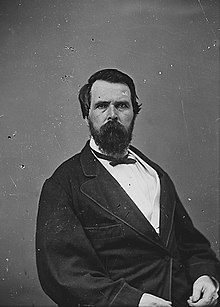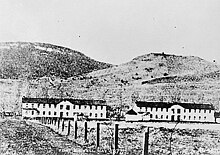John Bidwell
John Bidwell | |
|---|---|
 | |
| Member of theU.S. House of Representatives fromCalifornia's3rddistrict | |
| In office March 4, 1865 – March 3, 1867 | |
| Preceded by | Constituency established |
| Succeeded by | James Johnson |
| Member of theCalifornia Senate from theSacramentodistrict | |
| In office 1849–1851 | |
| Preceded by | Constituency established |
| Succeeded by | Alonzo W. Adams |
| Personal details | |
| Born | August 5, 1819 Chautauqua County,New York,U.S. |
| Died | April 4, 1900(aged 80) Chico,California |
| Political party | Democratic(Before 1864) Republican(1864–1875) Anti-Monopoly(1875–1888) Prohibition(1888–1900) |
| Spouse | Annie Kennedy |
| Residence | Bidwell Mansion |
| Military service | |
| Allegiance | California Republic |
| Rank | |
| Unit | California Battalion |
| Battles/wars | Mexican–American War Bear Flag Revolt |
John Bidwell(August 5, 1819 – April 4, 1900), known inSpanishasDon Juan Bidwell,[1]was an American pioneer, politician, and soldier. Bidwell is known as the founder of the city ofChico, California.
Born in New York, he emigrated at the age of 22 toAlta California(then a part of Mexico) as part of theBartleson–Bidwell Party,one of the first expeditions of American emigrants along theCalifornia Trail.In California, he became a Mexican citizen and a prominent landowner, receiving multiplerancho grantsfrom thegovernors of Alta California.Following the U.S.Conquest of California,Bidwell went on to serve in theCalifornia Senateand then in theU.S. House of Representatives.
Biography[edit]
Bidwell was born in 1819 inChautauqua County, New York.His Bidwell ancestors immigrated to North America in the colonial era.[2]His family moved toErie, Pennsylvania,in 1829, and then toAshtabula County, Ohio,in 1831.[3]At age 17, he attended and shortly thereafter became principal ofKingsville Academy.[4]
In 1841, at the age of 22, Bidwell became one of the first emigrants on the California Trail.[5]John Sutteremployed Bidwell as his business manager shortly after the younger man reached California. In October 1844, Bidwell went with Sutter to Monterey, where the two learned of an insurrection by leaderJosé Castroand ex-governorJuan Bautista Alvarado.[6]In 1845, Bidwell and Sutter joined GovernorManuel Micheltorenaand a group of Americans and Indians to fight the insurrectionists, pursuing them toCahuenga.[6]Micheltorena, Sutter, and Bidwell were imprisoned, and the latter two were shortly thereafter released.[6]
Upon release, Bidwell headed north throughPlacerita Canyon,saw the mining operations, and was determined to search for gold on his way toSutter's Fort,where he metJames W. Marshall.[7]Shortly after Marshall's discovery of gold atSutter's Mill,Bidwell also discovered gold on theFeather River,establishing a productive claim at Bidwell Bar in advance of theCalifornia Gold Rush.Bidwell obtained the four square-leagueRancho Los Ulpinosland grant after being naturalized as a Mexican citizen in 1844, and the two square-leagueRancho Colusgrant on theSacramento Riverin 1845. He later sold the latter grant and boughtRancho Arroyo Chicoon Chico Creek to establish a ranch and farm.
Bidwell attained the rank of major while fighting in theMexican–American Warand fighting atFort Stockton.He was elected to theCalifornia Senatein 1849. He supervised conducting the federal census of California in 1850 and 1860, under national direction byJoseph C. G. Kennedy. Bidwell served as a delegate to the 1860 national convention of theU.S. Democratic Party.He was appointed brigadier general of theCalifornia Militiain 1863.[3]After switching parties, he was a delegate to the national convention of theRepublican Partyin 1864. That year he was elected to theU.S. House of Representatives,serving as a Republican representative for California from 1865 to 1867.
In 1863-64, Bidwell and other local financiers built theHumboldt Wagon Roadconnecting Chico to the mining districts of Nevada.[8]Around this time, in 1865, General Bidwell backed a petition from settlers atRed Bluff, Californiato protect Red Bluff's trail to theOwyhee MinesofIdaho.TheUnited States Armycommissioned seven forts for this purpose. One site was nearFandango Passat the base of theWarner Mountains,in the north end ofSurprise Valley.On June 10, 1865, what was namedFort Bidwellwas ordered to be built there.[9][10]The fort was built amid escalating fighting with theSnake Indiansof eastern Oregon and southern Idaho.[11]It was a base for US Army operations in theSnake War,that lasted until 1868, and the laterModoc War.Although traffic dwindled on the Red Bluff route once theCentral Pacific Railroadextended into Nevada in 1868, the Army staffed Fort Bidwell until 1890 to quell various uprisings and disturbances.[9]APaiutereservation and small community maintain the name Fort Bidwell.

In 1868 Bidwell was about 49 when he marriedAnnie Kennedy,whom he had courted for years. She was 20 years younger and a daughter ofJoseph C. G. Kennedy.Her father was socially prominent, a high-rankingWashingtonofficial who supervised theU.S. Census Bureau.Bidwell had met him while working on the California census. The senior Kennedy was active in theU.S. Whig party.Annie Kennedy was deeply religious, joining the Presbyterian Church, and committed to a number of moral and social causes. She was very active in thesuffrageandprohibitionmovements.[3]
The couple married April 16, 1868 in Washington, D.C., withPresidentAndrew Johnsonand future presidentUlysses S. Grantamong the guests. After he returned with her to Chico, the Bidwells used their mansion extensively for entertainment of friends and official guests. Among them were PresidentRutherford B. Hayes,GeneralWilliam T. Sherman,Susan B. Anthony,Frances Willard,GovernorLeland Stanford,John Muir,Joseph Dalton Hooker,andAsa Gray.
In 1875, Bidwell ran forGovernor of Californiaon theAnti-Monopoly Partyticket.[3]As a strong advocate of thetemperance movement,he was theProhibition Partynominee for governor in 1880 and presided over the party's state convention in 1888.[3]In the1892 presidential election,Bidwell was the nominee of the Prohibition Party.[3]The ticket of Bidwell andJames B. CranfillofTexasfinished fourth nationwide, receiving 271,058 votes, or 2.3%. It was the largest total vote and highest percentage of the vote received by any Prohibition Party national ticket.
John Bidwell's autobiography,Echoes of the Past,was published in 1900. The Bidwell Family Papers are held at theBancroft Library.That same year, Bidwell died of natural causes on April 4, at the age of 80.
The actor Howard Negley (1898–1983) played Bidwell in the 1953 episode, "The Lady with the Blue Silk Umbrella" on thesyndicatedtelevision anthology series,Death Valley Days,hosted byStanley Andrews.In the story line, Helen Crosby (Kathleen Case) carries official California statehood papers in her umbrella to shield them from ruffians who want to destroy the documents.Rick Vallinplayed Lieutenant Bob Hastings.[12]
Fraternal allegiance[edit]
Bidwell was aFreemasonfor a time but left the group. He said that allegiance to the fraternity "was pointless" in an October 17, 1867 letter toAnnie Kennedy,whom he had been courting. His signature appears in the Book of By-Laws of the Chico-Leland Stanford Lodge No. 111 in Chico, California.[13]
See also[edit]
- Bartleson–Bidwell Party
- California Republic
- Bidwell Mansion State Historic Park
- California Trail
- Michael Gillis
- Temperance movement
Citations[edit]
- ^Jimeno's and Hartnell's Indexes of Land Concessions, from 1830 to 1846
- ^Bidwell, Edwin M. (1884)."Genealogy to the Seventh Generation of the Bidwell Family in America".
- ^abcdef"John Bidwell-Biography".Spartacus Education. 2006. Archived fromthe originalon 2007-01-01.Retrieved2006-12-11.
- ^"Guide to the John Bidwell Papers".content.cdlib.org.Archived fromthe originalon 2020-12-05.Retrieved2017-02-27.
- ^Michael J. Gillis and Michael F. Magliari,John Bidwell and California: The Life and Writings of a Pioneer, 1841-1900,ISBN0-87062-332-X,p. 31–
- ^abcBoyle, C. C. (1906).Addresses, Reminiscences, Etc. of General John Bidwell.p. 42.
- ^Worden, Leon (October 2005)."California's REAL First Gold".COINage magazine.RetrievedApril 16,2007.
- ^Leicester, Marti; Nopel, David (2012).The Humboldt Wagon Road.Images of America. Charleston, SC: Arcadia Publishing. p. 8.ISBN978-0-7385-7643-5.
- ^abPease, Robert W. (1965).Modoc County; University of California Publications in Geography, Volume 17.Berkeley and Los Angeles: University of California Press. pp. 75–78, 97.
- ^War Department, United States;John Sheldon Moody; Calvin Duvall Cowles; Frederick Caryton Ainsworth; Robert N. Scott; Henry Martyn Lazelle; George Breckenridge Davis; Leslie J. Perry; Joseph William Kirkley (1897).The War of the Rebellion: a Compilation of the Official Records of the Union and Confederate Armies.Vol. L. Washington: Government Printing Office. pp. 593–594, 1125, 1214–1215.
- ^Durham, David L. (1998).California's Geographic Names: A Gazetteer of Historic and Modern Names of the State.Clovis, Calif.: Word Dancer Press. p. 378.ISBN1-884995-14-4.
- ^"The Lady with the Blue Silk Umbrella onDeath Valley Days".Internet Movie Database.RetrievedJuly 3,2019.
- ^Michael J. Gillis and Michael F. Magliari,John Bidwell and California: The Life and Writings of a Pioneer, 1841-1900,ISBN0-87062-332-X,p. 223-224
External links[edit]
- Bigler Family collection, 1852–1918. Collection guide, California State Library, California History Room.
- "The First Emigrant Train to California"by John Bidwell
- "Bidwell-Bartleson Trail Guide"by Roy D. Tea
- Autobiography and Reminiscence of John Bidwell, San Francisco, 1904[permanent dead link][Transcription]. The Society of California Pioneers, via Calisphere.
- Guide to the Bidwell Family PapersatThe Bancroft Library
- United States Congress."John Bidwell (id: B000447)".Biographical Directory of the United States Congress.
- 1819 births
- 1900 deaths
- 19th-century American businesspeople
- 19th-century American inventors
- 19th-century American legislators
- 19th-century American male writers
- 19th-century American non-fiction writers
- American city founders
- American conservationists
- American explorers
- American geologists
- American gold prospectors
- American hunters
- American male non-fiction writers
- American military personnel of the Mexican–American War
- American mountain climbers
- American naturalists
- American people of the Bear Flag Revolt
- Temperance activists from California
- Anti-Monopoly Party politicians
- Brigadier generals
- California pioneers
- American emigrants to Mexico
- People of the Californias
- California Prohibitionists
- Democratic Party California state senators
- Candidates in the 1892 United States presidential election
- Explorers of California
- History of the Sierra Nevada (United States)
- Landowners from California
- People from Chico, California
- People from Chautauqua County, New York
- People of the Conquest of California
- Prohibition Party (United States) presidential nominees
- Republican Party members of the United States House of Representatives from California
- Writers from California
- Bartleson–Bidwell Party

